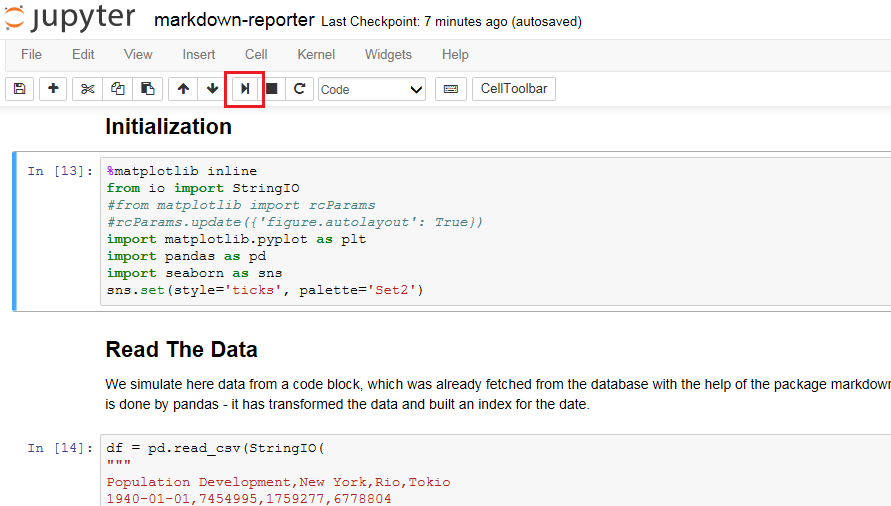Learning Objectives
After completing this page, you will be able to:
- Python IDEs Thonny, Geany and Idle Python is definitely the language to learn these days. If you are interested in Data Science, Data Analysis, Artificial Intelligence, then Python is the programming language that you are likely to use. But Python is a great general purpose language, too.
- Recall that a Jupyter Notebook is a series of cells that can store text or code. Cells shape a notebook’s core. Markdown Cells allows you to write and render Markdown syntax. Here’s where you can.
- Markdown in Jupyter Notebook Headings. The Headings starts with '#,' i.e., hash symbol followed by the space, and there are six Headings with the. Blockquotes can hold the large chunk of text and are generally indented. Both of the syntaxes above. The Code section.
- The Jupyter ecosystem contains many useful tools for working with Python including Jupyter Notebook, an interactive coding environment. Learn how to work with cells, including Python code and Markdown text cells, in Jupyter Notebook.
The Python Markdown extension allows displaying output produced by the current kernel in markdown cells. The extensions is basically agnostic to the kernel language, however most testing has been done using Python. For example: If you set variable a in Python a = 1.23.
- Create new Code and
Markdowncells withinJupyter Notebook. - Run Code and
Markdowncells withinJupyter Notebookto executePythoncode and renderMarkdowntext. - List useful shortcuts for common tasks in
Jupyter Notebook.
Work With Python Code and Markdown Cells in Jupyter Notebook
Recall that a Jupyter Notebook file consists of a set of cells that can store text or code.
- Text Cells: Text cells allow you to write and render
Markdownsyntax. This is where you can describe and document your workflow. - Code Cells: Code cells allow you to write and run programming code (e.g.
Python).
Create New Cells
You can use either the Menu tools or Keyboard Shortcuts to create new cells.
| Function | Keyboard Shortcut | Menu Tools |
|---|---|---|
| Create new cell | Esc + a (above), Esc + b (below) | Insert→ Insert Cell Above OR Insert → Insert Cell Below |
| Copy Cell | c | Copy Key |
| Paste Cell | v | Paste Key |
While the default cell type for new cells is Code, you can change the cell type of any existing cell by clicking in the cell and selecting a new cell type (e.g. Markdown) in the cell type menu in the toolbar.
Cell type options include Code, Markdown, Raw NBConvert (for text to remain unmodified by nbconvert), and Heading.
To use the Keyboard Shortcuts, hit the esc key. After that, you can change a cell to Markdown by hitting the m key, or you can change a cell to Code by hitting the y key. Playstation 3 eye camera driver windows 10.
Run Cells
Python Code Cells
You can run any cell in Jupyter Notebook (regardless of whether it contains Code or Markdown) using the Menu tools or Keyboard Shortcuts.
| Function | Keyboard Shortcut | Menu Tools |
|---|---|---|
| Run Cell | Ctrl + enter | Cell → Run Cell |
For example, you can add a new Code cell and then run the following Python code (e.g. 3 + 4). Your result, or output, will be displayed below the Code cell that you run.
Markdown Cells
.png)
You can run Markdown cells in the same way that you can run code cells. However, when you run a Markdown cell, the text formatted using Markdown syntax will be rendered as stylized text.

This means that headings are larger and bold, bulleted lists have bullets next to them instead of *, and regular text looks normal. No outputs will appear below the Markdown cell.
For example, the Markdown syntax below represents 3 headers. You can double-click in any Markdown cell to see the raw Markdown syntax, which for the cell below would appear like this raw Markdown syntax:
To see the Markdown as stylized text, run the cell. Sansui itl 1401 32 sound drivers. It should look like the text printed below:
Jupyter Markdown Guide
This is a subtitle in Markdown
This is a smaller subtitle
Jupyter Lab Markdown

This is an even smaller subtitle
Rearrange Cells in a Jupyter Notebook
You can change the order of cells within Jupyter Notebook using the up arrow and down arrow buttons on the menu bar. To do this, click inside the cell that you want to move and then press the desired arrow as many times as you need to move the Cell to the desired location.
Clear Results in Jupyter Notebook
Sometimes, you may want to clear any output results that have been produced. You can do this using the Menu:
| Menu Tools |
|---|
| Cell -> Current Outputs -> Clear |
Jupyter Markdown Reference
This will clear the current cell that you are working in, which you can activate by clicking in a cell.
You can also clear all of the output using the Menu Tools.
| Menu Tools |
|---|
| Cell -> All Output -> Clear |
